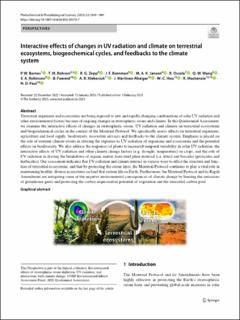| dc.contributor.author | Barnes, P.W. | |
| dc.contributor.author | Robson, T.M. | |
| dc.contributor.author | Zepp, R.G. | |
| dc.contributor.author | Bornman, J.F. | |
| dc.contributor.author | Jansen, M.A.K. | |
| dc.contributor.author | Ossola, R. | |
| dc.contributor.author | Wang, Q.-W. | |
| dc.contributor.author | Robinson, S.A. | |
| dc.contributor.author | Føreid, Bente | |
| dc.contributor.author | Klekociuk, A.R. | |
| dc.contributor.author | Martinez-Abaigar, J. | |
| dc.contributor.author | Hou, W.-C. | |
| dc.contributor.author | Mackenzie, R. | |
| dc.contributor.author | Paul, N.D. | |
| dc.date.accessioned | 2023-10-05T08:20:12Z | |
| dc.date.available | 2023-10-05T08:20:12Z | |
| dc.date.created | 2023-05-04T14:07:04Z | |
| dc.date.issued | 2023-02-01 | |
| dc.identifier.citation | Photochemical and Photobiological Sciences. 2023, 22 1049-1091. | en_US |
| dc.identifier.issn | 1474-905X | |
| dc.identifier.uri | https://hdl.handle.net/11250/3094369 | |
| dc.description.abstract | Terrestrial organisms and ecosystems are being exposed to new and rapidly changing combinations of solar UV radiation and other environmental factors because of ongoing changes in stratospheric ozone and climate. In this Quadrennial Assessment, we examine the interactive effects of changes in stratospheric ozone, UV radiation and climate on terrestrial ecosystems and biogeochemical cycles in the context of the Montreal Protocol. We specifically assess effects on terrestrial organisms, agriculture and food supply, biodiversity, ecosystem services and feedbacks to the climate system. Emphasis is placed on the role of extreme climate events in altering the exposure to UV radiation of organisms and ecosystems and the potential effects on biodiversity. We also address the responses of plants to increased temporal variability in solar UV radiation, the interactive effects of UV radiation and other climate change factors (e.g. drought, temperature) on crops, and the role of UV radiation in driving the breakdown of organic matter from dead plant material (i.e. litter) and biocides (pesticides and herbicides). Our assessment indicates that UV radiation and climate interact in various ways to affect the structure and function of terrestrial ecosystems, and that by protecting the ozone layer, the Montreal Protocol continues to play a vital role in maintaining healthy, diverse ecosystems on land that sustain life on Earth. Furthermore, the Montreal Protocol and its Kigali Amendment are mitigating some of the negative environmental consequences of climate change by limiting the emissions of greenhouse gases and protecting the carbon sequestration potential of vegetation and the terrestrial carbon pool. | en_US |
| dc.language.iso | eng | en_US |
| dc.publisher | Springer Nature | en_US |
| dc.rights | Navngivelse 4.0 Internasjonal | * |
| dc.rights.uri | http://creativecommons.org/licenses/by/4.0/deed.no | * |
| dc.title | Interactive effects of changes in UV radiation and climate on terrestrial ecosystems, biogeochemical cycles, and feedbacks to the climate system | en_US |
| dc.title.alternative | Interactive effects of changes in UV radiation and climate on terrestrial ecosystems, biogeochemical cycles, and feedbacks to the climate system | en_US |
| dc.type | Peer reviewed | en_US |
| dc.type | Journal article | en_US |
| dc.description.version | publishedVersion | en_US |
| dc.rights.holder | © The Author(s) 2023 | en_US |
| dc.source.pagenumber | 1049-1091 | en_US |
| dc.source.volume | 22 | en_US |
| dc.source.journal | Photochemical and Photobiological Sciences | en_US |
| dc.identifier.doi | 10.1007/s43630-023-00376-7 | |
| dc.identifier.cristin | 2145541 | |
| cristin.ispublished | true | |
| cristin.fulltext | original | |
| cristin.fulltext | original | |
| cristin.qualitycode | 1 | |

